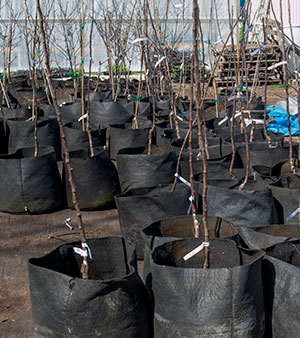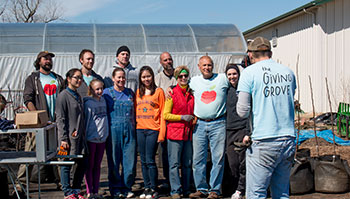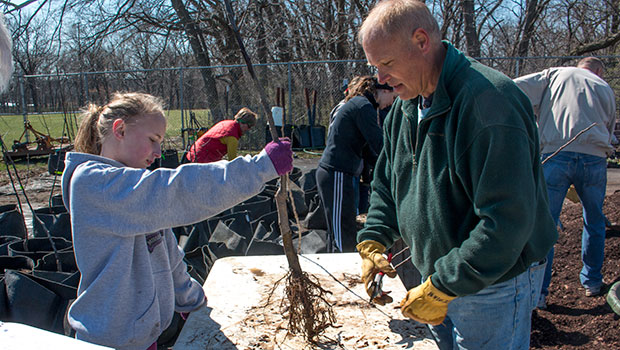By Joe Lambe
Rob Reiman trimmed bare fruit tree roots Thursday and passed saplings to volunteers who potted them.
By days end, they intended to have 400 apple and pear trees ready for fall planting. They will go in neighborhoods and around schools and churches and other urban sites.
The mission of the Giving Grove, an operation of Kansas City Community Gardens, is to provide food for the needy.
 As it starts its third year, the group has planted 754 trees that will produce more than 200,000 pounds of fruit annually, said Reiman, Giving Grove executive director.
As it starts its third year, the group has planted 754 trees that will produce more than 200,000 pounds of fruit annually, said Reiman, Giving Grove executive director.
“I think we’re going to make a meaningful impact on hunger in Kansas City,” he said. “Ultimately I think this is something every city in the country is going to emulate.”
He kept clipping roots while he told of the strong root grafts, the types of trees and operation history.
The cut roots will grow stronger in the special soft, pliable containers that will allow the roots to spread and grow through them. When the roots hit air, they self prune and prevent the balled root mass of common hard pots.
The Giving Grove concept started with church activists who fed the homeless but wanted to do more, Reiman said.
It is not clear where the fall trees will go yet, he said. In the past, many have been planted along Troost and Prospect, among other places.
 But they also have them at the Barstow school and at the adult residential center of Johnson County Community Corrections, where inmates tend them.
But they also have them at the Barstow school and at the adult residential center of Johnson County Community Corrections, where inmates tend them.
A portion of the fruit at such places goes to food pantries for the homeless.
Reiman clipped away, while he spoke with the enthusiasm of a modern Johnny Appleseed. He said people approached him after he retired and asked him to get involved in the program.
“When we started putting pencil to paper about the potential impact, I thought I have to do this,” he said. “We will have hundreds of these orchards in the city before too long.”
When he meets with neighborhood groups, he said, someone always says, “Everybody used to have a fruit tree, what happened?”
After the World War II, “Victory gardens” and fruit trees were common before food became a commodity, Reiman said. “It’s just a lost art now.”
But the trees are also a commitment for those who get them. The group will not put them in unless specific people pledge to take care of them.
Giving Grove uses strong tree varieties to resist diseases and allows only organic biological treatments, he said.
On April 1, they will start planting 170 other spring trees.
As the first shift of volunteers left Thursday, Reiman thanked them and noted that each of the fall trees would someday produce 300 to 400 pounds of fruit a year.
“Think of the impact,” he said. “It’s huge.”
People who want more information, or to apply for trees, can do so at the group’s website.




When we began planting trees in the 4000 block of Forest, neighbors stepped up to help. Now several have their own, and there’s talk of peach cobbler and a peach festival. Food and community – love the combination!